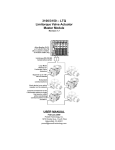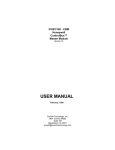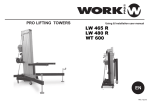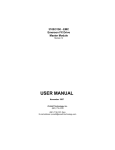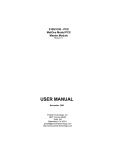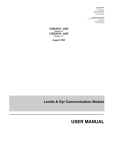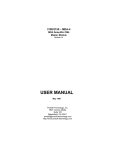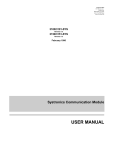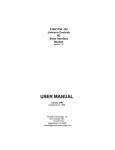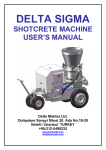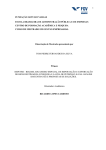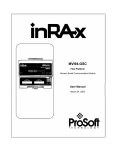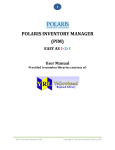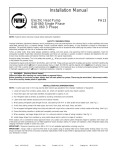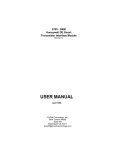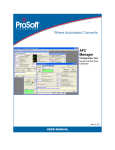Download 3100/3150-YRK User Manual
Transcript
3100/3150 - YRK York Chiller Master Module Revision 1.0 USER MANUAL April, 1997 ProSoft Technology, Inc. 9801 Camino Media Suite 105 Bakersfield, CA 93311 [email protected] Please Read This Notice Successful application of the YRK card requires a reasonable working knowledge of the Allen-Bradley PLC or SLC hardware and the application in which the combination is to be used. For this reason, it is important that those responsible for implementing the YRK satisfy themselves that the combination will meet the needs of the application without exposing personnel or equipment to unsafe or inappropriate working conditions. This manual is provided to assist the user. Every attempt has been made to assure that the information provided is accurate and a true reflection of the product's installation requirements. In order to assure a complete understanding of the operation of the product, the user should read all applicable Allen-Bradley documentation on the operation of the A-B hardware. Under no conditions will ProSoft Technology, Inc. be responsible or liable for indirect or consequential damages resulting from the use or application of the YRK product. Reproduction of the contents of this manual, in whole or in part, without written permission from ProSoft Technology, Inc. is prohibited. Information in this manual is subject to change without notice and does not represent a commitment on the part of ProSoft Technology, Inc. Improvements and/or changes in this manual or the product may be made at any time. These changes will be made periodically to correct technical inaccuracies or typographical errors. Copyright 1997, ProSoft Technology Inc. Product Revision History 04/9/97 Revision 1.0 Initial release of product Implementation Guide Integration of the YRK module into a PLC or SLC application is easier the first time if a series of steps are followed. In order to assist the first time users of our products in getting the YRK operational quickly, we have come up with this step-by-step implementation guide. a) Starting with one of the ladder logic programs provided on disk with the YRK complete the following steps: PLC 5 YRK5 SLC 5/03 YRK503 b) Edit the ladder logic provided on disk as needed for the application Verify rack and slot location in program Modify ladder instruction addresses as needed Reference Appendix for tips in the SLC platform c) Setup the Communication Configuration parameters (See Section 2) Determine the configuration requirements: Baud Rate, Number of slaves, page map requirements, etc. d) Identify the jumper requirements (See Appendix) e) Make up the communication cables (See Section 5) f) Place processor into the run mode g) Monitor the data table Error Status values (See Section 2) ii Table of Contents Revision History Implementation Guide i i 1 Product Specifications ............................................................................................................................1 2 YRK Theoretical Operation .....................................................................................................................1 2.1 Block Transferring Data to the Module .............................................................................................2 2.1.1 Communications Configuration [ BTW Block ID 255 ] ................................................................2 2.1.2 Write Page Data Command Blocks [ BTW Block ID Code 0 to 5 ]..............................................4 2.1.3 Page Polling List [ BTW Block ID Code 80 and 81 ] ...................................................................7 2.2 Transferring data from the module [ BTR Block ID 0 to 59 ]..............................................................9 2.2.1 The Read Data Block Structure .................................................................................................9 2.2.2 Moving the data from the module to the processor.....................................................................9 2.2.3 Slave Data Results..................................................................................................................10 2.2.4 Command Done Bits ...............................................................................................................12 2.2.5 Module Information Table........................................................................................................13 3 Protocol Commands.............................................................................................................................13 4 Diagnostics and Troubleshooting ..........................................................................................................14 4.1 3100 PLC Platform LED Indicators.................................................................................................14 4.2 3150 SLC Platform LED Indicators.................................................................................................15 4.3 Troubleshooting - General..............................................................................................................16 4.4 Communication Error Codes..........................................................................................................17 5 Cable Connection .................................................................................................................................17 Appendix Support, Service and Warranty Jumper Configurations SLC Programming Considerations Example Ladder Logic PLC-5 SLC-5/03 1 Product Specifications The 3100/3150-YRK (“York Master Module”) product family allows Allen-Bradley 1771 and 1746 I/O compatible processors to easily interface as a host with up to 15 York Chillers per port. The YRK product includes the following standard features: General Specifications • Support for up to 14 York chillers per port • RS-232 or RS-485 communications (jumper selectable) • Software configuration (From processor ladder logic) Baud Rate : 1,200 TO 38,400 Message Response Timeout Number of active slaves : 1 to 15 per port Prioritized Page Polling List : Up to 90 entries Active Slave Table • Response time The protocol drivers are written in Assembly and in a compiled higher level language. As such, the interrupt capabilities of the hardware are fully utilized to minimize delays, and to optimize the product's performance Hardware Specifications Backplane Current Load : 3100 : 0.65 A 3150 : 0.15 A at 5 V 0.04 A at 24 V • Operating Temperature : 0 to 60 °C • Storage Temperature : -40 to 85 °C • Connections : 3100 : 2 - DB25 Female Connectors 3150 : 2 - DB9 Male Connectors • 2 YRK Theoretical Operation Data transfers between the processor and the ProSoft Technology module occur using the Block Transfer commands, in the case of the PLC, and M0/M1 data transfer commands, in the case of the SLC. These commands transfer up to 64 physical registers per transfer. The logical data length changes depending on the data transfer function. The following discussion details the data structures used to transfer the different types of data between the ProSoft Technology module and the processor. The term 'Block Transfer' is used generically in the following discussion to depict the transfer of data blocks between the processor and the ProSoft Technology module. Although a true Block Transfer function does not exist in the SLC, we have implemented a pseudo-block transfer command in order to assure data integrity at the block level. Examples of the PLC and SLC ladder logic are included in Appendix A. In order for the ProSoft Technology module to function, the PLC must be in the RUN mode, or in the REM RUN mode. If in any other mode (Fault/PGM), the block transfers between the PLC and the module will stop, and communications will halt until block transfers resume. 1 2.1 Block Transferring Data to the Module Data transfer to the module from the processor is executed through the Block Transfer Write function. The different types of data which are transferred require slightly different data block structures, but the basic data structure is: Word 0 Name BTW Block ID 1 to 63 Data Description A block page identifier code. This code is used by the ProSoft module to determine what to do with the data block. Valid codes are: BTW Code Description 0-2 Port 1 Write Enable and Data 3-5 Port 2 Write Enable and Data 80-81 Page Polling List (Prioritized) 255 Module Communication Configuration The data to be written to the module. The structure of the data is dependent on the Block ID code. The following sections provide details on the different structures. PLC Memory BTW Block ID Port 1 Port 2 0 Chillers 1-5 Write Data 1 Chillers 6-10 Write Data 2 Chillers 11-14 Write Data 3 Chillers 1-5 Write Data 4 Chillers 6-10 Write Data 5 Chillers 11-14 Write Data 255 Configuration Data BTW Command Word 0 1 2 3 4 : : : 63 BTW Block ID Although the full physical 64 words of the data buffer may not be used, the BTW and M0 lengths must be configured for 64 words otherwise module operation will be unpredictable. 2.1.1 Communications Configuration [ BTW Block ID 255 ] The ProSoft Technology module communication parameters must be configured at least once when the card is first powered up, and any time thereafter when the parameters must be changed. On power up, the module enters into a logical loop waiting to receive configuration data from the processor. While waiting, the module sets the second word of the BTR buffer to 255, telling the processor that the module must be configured before anything else will be done. The module will continuously perform block transfers until the communications configuration parameters block is received. Upon receipt, the module will begin execution of the command list if present, or begin looking for the command list from the processor. 2 Transferring the Communications Configuration Parameters to the module will force a reset of the communication ports The configuration data block structure which must be transferred from the processor to the module is as follows: BTW Data Buffer Word Description 0 Block ID Header = 255 Configuration Parameters 1 N[ ]:0 Baud Rate 2 N[ ]:1 Response Timeout 3 N[ ]:2 Port 1 - Max Number of Slaves 4 N[ ]:3 Port 2 - Max Number of Slaves 5 N[ ]:4 Read Block Count 6 N[ ]:5 Block Transfer Delay Count 7 N[ ]:6 Last State on Comm Fail 8-10 N[ ]:7-9 Spare Active Slave Table 11-24 N[ ]:10-24 Port 1 - Slave Addresses(Up to 15 slaves) 25-39 N[ ]:25-39 Port 2 - Slave Addresses(Up to 15 slaves) Configuration Memory map for Example Application Baud Rate Port 1 Slave Count Response Timeout Port 2 Slave Count Read Block Count BT Delay Count 0 1 2 3 4 5 6 7 8 9 N7:0 5 500 2 0 4 0 0 0 0 0 Configuration Parm N7:10 1 2 0 0 0 0 0 0 0 0 Port 1 - Active Slave Table N7:20 0 0 0 0 0 0 0 0 0 0 N7:30 0 0 0 0 0 0 0 0 0 0 Port 2 - Active Slave Table 3 Name Description Baud Rate The baud rate at which the port is to operate. The available configurations are as follows: Value Baud Rate 2 1200 Baud 3 2400 Baud 4 4800 Baud 5 9600 Baud * 6 19200 Baud 7 38400 Baud * York Field Unit Factory Default Setting Message Response Timeout This register represents the message response timeout period in 1 ms increments. This is the time which a port configured as a Master will wait before re-transmitting a command if no response is received from the addressed slave. The value is set depending on the expected slave response times. The module has been hardcoded with a minimum value of 20000 (20 seconds) in order to assure that the unit works when a chiller is down. Therefore a value of 0 may normally be entered in this register. This value is used by the module to optimize the number of data blocks returned to the PLC data table as well as several of the internal logic routines. The value entered here can range from 1 to 15. Port 1 - Max Number of Slaves Port 2 - Max Number of Slaves Read Data Block Count This value represents the number of 50 word data blocks which are to be transferred from the YRK Module to the processor. The blocks returned from the module start at block 0 and increment from there. The maximum block count is 80. Two blocks per active slave should be requested. As an example, if there are 2 active slaves on port 1, a value of 4 should be requested to return module registers 0 to 199. If a value of 0 is entered the YRK module uses the Number of Slaves configuration value to determine the Read Block Count value. Block Transfer Delay Counter This is an empirical value used by the module to balance the amount of time the module spends block transferring and the amount spent handling port communications. The value entered is used as a loop counter in the module, where each time through the loop the count is incremented. When the count equals the Block Transfer Delay Counter a Block Transfer sequence is initiated. A value of zero (0) is suggested unless directed differently by the factory. Example : In Master Mode applications with the module in a remote rack, the frequency of command execution can be improved by entering a value of 75-150. The value must be determined empirically. Port 1 – Active Slave Table Port 2 - Active Slave Table 2.1.2 These 15 words allow the user to configure the specific slaves addresses which are active on a network. The intent of this table is to allow the user to selectively enable slave addresses and therefore not having to have sequential slave addressing. Write Page Data Command Blocks [ BTW Block ID Code 0 to 5 ] A YRK Master port establishes communications and performs various communications functions based on the data which the user has placed in the Command Blocks. The Command Blocks are 50 word data blocks containing bit mapped ‘Enable Bits’ and actual write data. The actual command which is executed by the module is determined by the user setting the correct ‘Enable Bit’ to a 1. 4 All commands are one-shoted by the module (ie., the module must see a 1 to 0 transition before the command can be re-enabled with a 0 to 1 transition). The user may use the ‘Cmd Done Bit’ (See next section) to clear the command or any other means appropriate. This command data, entered into the processor Data Table, is transferred to the module's memory using Block IDs 0 through 5, depending on the command to be executed. The structure of the data for each slave position is broken down as follows: Important Note For the 8 available pages that can be written to (Page 1 to 8), the module is coded to assume the following data types for the pages: Pages 1 to 4 : Analog Pages 5 to 8 : Discrete Word 0 Name Command Enable Description This is a bit mapped word which contains the individual page write command enables. This bit is one-shoted by the module to assure that the write command is only written once. This bit can be cleared in ladder logic using the Done bit returned from the module. Bit Description 0 Cmd Enable - Page Number 1 1 Cmd Enable - Page Number 2 2 Cmd Enable - Page Number 3 3 Cmd Enable - Page Number 4 4 Cmd Enable - Page Number 5 5 Cmd Enable - Page Number 6 6 Cmd Enable - Page Number 7 7 Cmd Enable - Page Number 8 1-8 Write Data These values are the actual data values (x10) to be written to the slave. Example: 121 will write a value of 12.1 to the chiller 9 Spare Not Used Command Enable Word Spare Data for Pages 1 - 8 0 1 2 3 4 5 6 7 8 9 8 0 0 0 0 0 0 0 0 0 Port 1 Command Blocks Word 0 1 to 10 11 to 20 21 to 30 31 to 40 41 to 50 Command Block Structure Description BTW Block ID Code ( = 0 ) Slave Position #1 - Enable and Data Slave Position #2 - Enable and Data Slave Position #3 - Enable and Data Slave Position #4 - Enable and Data Slave Position #5 - Enable and Data Word 0 1 to 10 11 to 20 21 to 30 31 to 40 41 to 50 Description BTW Block ID Code ( = 1 ) Slave Position #6 - Enable and Data Slave Position #7 - Enable and Data Slave Position #8 - Enable and Data Slave Position #9 - Enable and Data Slave Position #10 - Enable and Data 5 Word 0 1 to 10 11 to 20 21 to 30 31 to 40 41 to 50 Description BTW Block ID Code ( = 2 ) Slave Position #11 - Enable and Data Slave Position #12 - Enable and Data Slave Position #13 - Enable and Data Slave Position #14 - Enable and Data Slave Position #15 - Enable and Data Port 2 Command Blocks Word 0 1 to 10 11 to 20 21 to 30 31 to 40 41 to 50 Description BTW Block ID Code ( = 3) Slave Position #1 - Enable and Data Slave Position #2 - Enable and Data Slave Position #3 - Enable and Data Slave Position #4 - Enable and Data Slave Position #5 - Enable and Data Word 0 1 to 10 11 to 20 21 to 30 31 to 40 41 to 50 Description BTW Block ID Code ( = 4) Slave Position #6 - Enable and Data Slave Position #7 - Enable and Data Slave Position #8 - Enable and Data Slave Position #9 - Enable and Data Slave Position #10 - Enable and Data Word 0 1 to 10 11 to 20 21 to 30 31 to 40 41 to 50 Description BTW Block ID Code ( = 5) Slave Position #11 - Enable and Data Slave Position #12 - Enable and Data Slave Position #13 - Enable and Data Slave Position #14 - Enable and Data Slave Position #15 - Enable and Data Command Blocks Port #1 Block ID 0 0 1 2 3 4 5 6 7 8 9 N10:0 0 0 0 0 0 0 0 0 0 0 Slave Position #1 N10:10 0 0 0 0 0 0 0 0 0 0 Slave Position #2 N10:20 0 0 0 0 0 0 0 0 0 0 Slave Position #3 N10:30 0 0 0 0 0 0 0 0 0 0 Slave Position #4 N10:40 0 0 0 0 0 0 0 0 0 0 Slave Position #5 Block ID 1 N10:50 0 0 0 0 0 0 0 0 0 0 Slave Position #6 N10:60 1 0 0 0 0 0 0 0 0 0 Slave Position #7 N10:70 0 0 0 0 0 0 0 0 0 0 Slave Position #8 N10:80 0 0 0 0 0 0 0 0 0 0 Slave Position #9 N10:90 0 0 0 0 0 0 0 0 0 0 Slave Position #10 Block ID 2 6 N10:100 0 0 0 0 0 0 0 0 0 0 Slave Position #11 N10:110 0 0 0 0 0 0 0 0 0 0 Slave Position #12 N10:120 1 0 0 0 0 0 0 0 0 0 Slave Position #13 N10:130 0 0 0 0 0 0 0 0 0 0 Slave Position #14 N10:140 0 0 0 0 0 0 0 0 0 0 Slave Position #15 0 1 2 3 4 5 6 7 8 9 N11:0 0 0 0 0 0 0 0 0 0 0 Slave Position #1 N11:10 0 0 0 0 0 0 0 0 0 0 Slave Position #2 N11:20 0 0 0 0 0 0 0 0 0 0 Slave Position #3 N11:30 0 0 0 0 0 0 0 0 0 0 Slave Position #4 N11:40 0 0 0 0 0 0 0 0 0 0 Slave Position #5 Port #2 Block ID 3 Block ID 4 N11:50 0 0 0 0 0 0 0 0 0 0 Slave Position #6 N11:60 1 0 0 0 0 0 0 0 0 0 Slave Position #7 N11:70 0 0 0 0 0 0 0 0 0 0 Slave Position #8 N11:80 0 0 0 0 0 0 0 0 0 0 Slave Position #9 N11:90 0 0 0 0 0 0 0 0 0 0 Slave Position #10 + Block ID 5 2.1.3 N11:100 0 0 0 0 0 0 0 0 0 0 Slave Position #11 N11:110 0 0 0 0 0 0 0 0 0 0 Slave Position #12 N11:120 1 0 0 0 0 0 0 0 0 0 Slave Position #13 N11:130 0 0 0 0 0 0 0 0 0 0 Slave Position #14 N11:140 0 0 0 0 0 0 0 0 0 0 Slave Position #15 Page Polling List [ BTW Block ID Code 80 and 81 ] An YRK Master port collects data from the Chiller slaves based on Page numbers. The Page Polling List allows the user to configure which pages will be read from the slaves. The key thing to remember is that the Page Polling List applies to all active slaves. On power up or after module configuration (255 block) the module will set the second word of the BTR buffer to 80 and then 81, telling the processor that the module is expecting to receive the Page Polling List. The ladder logic, if active, must respond at this point with the appropriate BTW Block ID value (80/81 respectively). 7 The structure of the Page Polling List is as follows: BTW Buffer 0 1-10 11-20 21-50 Data Word Description Block ID Header = 80 N[ ]:0-9 High Priority Page Numbers (10) N[ ]:10-19 Medium Priority Page Numbers(10) N[ ]:20-49 Low Priority Page Numbers(30) 0 1-40 Block ID Header = 81 Low Priority Page Numbers(40) N[ ]:0-39 Note that the following polling frequency is followed based on priority type: High Priority Every Scan Med Priority Every 5th Scan Low Priority Every 13th Scan Floating Point Values Up to three floating point values can be returned from a York Chiller to the PLC. If a value is to be read and returned as a Float, the upper byte of the Page Number entry is used to identify this fact and also to locate the value in the three available floating point data positions. The possible values of the upper byte are as follows: Values 0 1 2 3 Description Integer value returned Float value returned. This value will be located in Floating Point Position #1 of the data returned from the module Float value returned. This value will be located in Floating Point Position #2 of the data returned from the module Float value returned. This value will be located in Floating Point Position #3 of the data returned from the module Block ID 80 0 1 2 3 4 5 6 7 8 9 N12:0 5 9 10 56 57 0 0 0 0 0 N12:10 1 2 14 15 58 69 70 71 72 74 N12:20 11 12 13 23 24 286 77 0 0 0 N12:30 0 0 0 0 0 0 0 0 0 0 N12:40 0 0 0 0 0 0 0 0 0 0 0 1 2 3 4 5 6 7 8 9 N12:50 1 0 0 0 0 0 0 0 0 0 N12:60 0 0 0 0 0 0 0 0 0 0 N12:70 0 0 0 0 0 0 0 0 0 0 N12:80 0 0 0 0 0 0 0 0 0 0 High Priority Pages Medium Priority pages Low Priority Pages (30 pages) Block ID 81 8 Low Priority Pages (40 pages) 2.2 Transferring data from the module [ BTR Block ID 0 to 59 ] When the YRK Master port driver reads data from a slave the resulting data is placed into the ProSoft module’s data space (Addresses 0 to 2999). The structure of each set of slave data is predetermined and programmed into the module (see below). The position of each slave’s data structure is a function of the position of the slave in the Port Active Slave List (See Configuration Section 2.1.1). The transfer of data from the ProSoft Technology module to the processor is executed through the Block Transfer Read function. The following sections detail the handling of the read data. Although the full physical 64 words of the data buffer may not be used, the BTR and M1 lengths must be configured for a length of 64 words, otherwise module operation will be unpredictable The ladder logic must be programmed to look at the BTR buffer, decode several words, and then take action. 2.2.1 The Read Data Block Structure The BTR buffer definition is: Word 0 Name BTR Block ID Description The ladder logic uses this value to determine the contents of the data portion of the BTR buffer. With some conditional testing in ladder logic, the data from the module can be placed into the PLC/SLC data table. The relationship between the BTR Block ID number and the register table can be put into an equation: Starting Register Address = Block ID Number * 50 Valid codes are between 0 and 79. 1 BTW Block ID The module returns this value to the processor to be used to enable the movement of and command data blocks to the module. BTR Buffer Word 0 1 2 3 4 : : : 63 2.2.2 2 to 51 (50 words) Data 52 to 61 (10 words) Command Done Bits BTR Block ID BTW Block ID BTW Buffer Word 0 1 2 3 4 : : : 63 BTW Block ID The contents of the module’s Register Data space (0 3999). The data will contain the slave data structure for up to 5 slaves. The structure is outlined below. These 10 words contain bit mapped Command Done Bits which correspond to the slave address (ie., bit 0 of the block corresponds to slave #1, etc). These bits are intended to be used to unlatch the Cmd Enable bits through ladder logic. Moving the data from the module to the processor The data register table is transferred from the module to the ladder logic through a paging mechanism designed to overcome the 64 physical word limit of the BTR instruction. The paging mechanism is outlined in the discussion above, but the important thing to understand is the relationship between the 9 page numbers (BTR Block ID numbers) and the register addresses in the module. The diagram also shows the layout for an example application. Note the number of blocks returned from the module to the ladder logic is determined by the value entered in the module’s configuration ‘Max Number of Slaves’ register, or if non-zero, the value in ‘Read Block Count’. In this example we have assumed a ‘Max Slave Count’ value of 15, allowing three (3) data blocks to be returned from the module. YRK Module Memory PLC Data Memory PLC Data Addr N13:0 Read Data Block Block ID 0 to 79 Address : 0 to 3999 0 Slave 1 Results Data Block N13:50 49 50 N13:100 99 100 N13:150 149 150 N13:200 199 200 N13:250 249 250 Block ID 0 Block ID 1 Block ID 2 Read Data from Slaves to PLC These data blocks being returned to the PLC will contain the slave data in pre-formatted structures. Each block will contain 50 words, with each slave consuming 100 words. It therefore takes two blocks to return all of a slaves data. Block ID 3 Block ID 4 Block ID 59 2999 Read Data Blocks being returned from the YRK module to the PLC data table. The actual number of data blocks returned from the module is determined by the Read Block Count value entered during module configuration ( 2 blocks required per active slave). 2.2.3 Slave Data Results The data values returned from each of the active slaves are placed in the module’s data table and then transferred over to the PLC data table for handling by the ladder logic. Several important points to understand include: 1. 2. 3. 4. The position of each slave’s data in the module is determined by the position of the slave in the Port Active Slave Table. A maximum of 30 slaves worth of data can be gathered from the module, up to 15 slaves per port Each slave position, whether activated in the Active Slave Table or not, has space reserved in the module Non-contiguous slaves in the Active Slave Table will result in holes in the data table being returned from the module. Although not normally a problem, caution should be exercised when selecting slave positions to minimize these hole (ie., reduce the number of Block Transfers needed to read back the data) 10 The structure of the 100 word Slave Data block when reading data from the module is as follows: Slave Data Response Block 0 1 2 3 4 5 6 7 8 9 0 1 0 0 0 0 0 0 0 0 0 Hi Priority Data 10 1 1 0 0 0 0 0 0 0 0 Medium Priority Data 20 0 0 0 0 0 0 0 0 0 0 Low Priority Data 30 0 0 0 0 0 0 0 0 0 0 40 0 0 0 0 0 0 0 0 0 0 50 0 0 0 0 0 0 0 0 0 0 60 0 0 0 0 0 0 0 0 0 0 70 0 0 0 0 0 0 0 0 0 0 80 0 0 0 0 0 0 0 0 0 0 90 0 0 0 0 0 0 0 0 0 0 Floating Point Values #1, #2 and #3 Comm Command Error Done Bits Command Counter Stage Slave Data response structure. Each slave position has 100 words reserved in the module in the structure shown in the diagram. where: Slave #x Response : The structure of each slaves read data and communication status data is as follows: Position 0-9 Name Hi Priority Read Data Description Data read from York Chiller based on Page Numbers entered in the Hi Priority Poll list. Please note that all data values are returned with an implied decimal point of 1 (ie., a chiller value of 10.0 will be returned to the PLC as 100). These value are read every scan of the page list. 10-19 Medium Priority Read Data Data read from York Chiller based on Page Numbers entered in the Medium Priority Poll list. Please note that all data values are returned with an implied decimal point of 1 (ie., a chiller value of 10.0 will be returned to th the PLC as 100). These values are read every 5 scan of the page list. 20-89 Lo Priority Read Data Data read from York Chiller based on Page Numbers entered in the Low Priority Poll list. Please note that all data values are returned with an implied decimal point of 1 (ie., a chiller value of 10.0 will be returned to the PLC th as 100). These values are read every 13 scan of the page list. 11 90-91 92-93 94-95 Floating Point Value #1, #2, and #3 Floating point image of data read back from the York Chiller. These 32-bits must be COPied into a float file location to read them in the PLC/SLC. These values are returned to the PLC in the same form as received from the chiller. 96 Communication Counter The is a roll over counter (0 to 32767) which increments upon completion of every successful communication transaction with a slave. This counter will increment on poll (read) commands as well as write commands 97 Communication Status Code Command Done Bits See Trouble Shooting Section Stage This is a status register indicating the operational state of the communications driver. The values are as follows: Value Description 0 Issue Login Command 1 Sending Password (Fixed at 1) 2 Send Open 0,ss Command 3 Send ‘e1e’ to gain access 4 Polling for data 5 Writing Data 6 Sending Close Link Command 10 Unknown State (powerup only) 98 99 2.2.4 These are bits returned as a result of executing a write command. See Section 2.12 for executing commands. See Section 2.2.4 for details on Command Done Bits. Command Done Bits The YRK Module returns ‘Command Done’ bits to the ladder logic. A Done bit is returned per Page Write Command per slave address, allowing ladder logic to be used to clear the Command Enable bits. The following important points should be noted about the Command Done bits: 1. 2. 3. There is only one bit returned per slave address, not one bit per command per slave. The implication of this is that one Done bit must be used to clear all possible Enable bits for one slave address. Example logic is provided in the Appendix demonstrating this The Command Done bit is a positive indication that the module executed the command. It is not an indication of the command’s success. A Done bit is returned to the ladder logic whether the command was completed without error or not. This allows all commands to be unlatched the same way. To determine if there is a communication problem with a slave, verify the Port Comm Status bits in the slave Status field. The Done bit data registers in the module are cleared and then updated prior to each backplane transfer sequence. This is done to assure that the ladder logic receives the quickest possible acknowledgment of a commands execution. The structure of the Command Done bits in the BTR buffer when reading data from the module is as follows: 12 Word 98 2.2.5 Bit 0 1 2 3 4 5 6 7 Description Cmd Done - Page Number 1 Cmd Done - Page Number 2 Cmd Done - Page Number 3 Cmd Done - Page Number 4 Cmd Done - Page Number 5 Cmd Done - Page Number 6 Cmd Done - Page Number 7 Cmd Done - Page Number 8 Module Information Table The YRK Module provides product data to the ladder logic during power up through the BTR data buffer whenever the BTW Block ID is set to 255. This data is useful for determining revision information and can be useful should support be necessary from the factory. This 10 word block of data is returned in the BTR data fields. Word 0 1 2-3 4-5 6-7 8-9 10-11 Description BTR Block ID Code BTW Block ID( =255 ) Product Name (ASCII) Revision (ASCII) Operating System Rev(ASCII) Production Run Number (ASCII) Spare Product Name: These two words represent the product name of the module in an ASCII representation. In the case of the YRK product, the letters ‘ YRK ‘ should be displayed when placing the programming software in the ASCII data representation mode. Revision : These two words represent the product revision level of the firmware in an ASCII representation. An example of the data displayed would be ‘1.01’ when placing the programming software in the ASCII data representation mode. Operating System Revision : These two words represent the module’s internal operating system revision level in an ASCII representation. Production Run Number: This number represents the ‘batch’ number that your particular chip belongs to in an ASCII representation. Revision Module Type N7:50 3 Operating System Batch Number 0 1 2 3 4 5 6 7 8 9 YR K 1. 00 09 0 0 0 0 0 Module Info Protocol Commands The ProSoft Technology YRK module Master module is pre-programmed to support a subset of the Modbus protocol. The commands are all hard coded into the module and have been selected to implement specific functionality. The commands which have been programmed are documented in the following table. For a more complete discussion on these and other commands for the York actuators, please reference the York Terminal Manual, available from York International Inc. Talk XL. 13 Command Open 0,ss close link logon/login logoff/logout list or r Password f02s01pxx e1e Description Open link to station ss on network 0 Close link to secondary station Change user End session List all pages of current option Hardcoded to a valued of 1 Read page command, where xx is page number Gain access rights after Open 0,ss Send Make/Start Command Send Stop/Open Command Send setpoint value e0e exx.xe 4 Diagnostics and Troubleshooting Several hardware diagnostics capabilities have been implemented using the LED indicator lights on the front of the module. The following sections explain the meaning of the individual LEDs for both the PLC and the SLC platforms. 4.1 3100-YRK PLC Platform LED Indicators The PLC platform YRK product is based on the ProSoft CIM hardware platform. The following table documents the LEDs on the 3100-YRK hardware and explains the operation of the LEDs. ProSoft CIM Card ACTIVE CFG ERR1 TXD1 RXD1 ProSoft CIM ACT Color Green Status Blink (Fast) On Off FLT Red Off On CFG Green Off Blink On BPLN Red Off On ¡¡ ¡¡ ¡¡ ¡¡ ¡¡ FLT BPLN ERR2 TXD2 RXD2 Indication Normal state : The module is operating normally and successfully Block Transferring with the PLC The module is receiving power from the backplane, but there may be some other problem The module is attempting to Block Transfer with the PLC and has failed. The PLC may be in the PGM mode or may be faulted Normal State : No system problems are detected during background diagnostics A system problem was detected during background diagnostics. Please contact factory for technical support Normal state : No configuration related activity is occurring at this time This light blinks every time a Module Configuration block (ID = 255) is received from the processor ladder logic The light is on continuously whenever a configuration error is detected. The error could be in the Port Configuration data or in the System Configuration data Normal State : When this light is off and the ACT light is blinking quickly, the module is actively Block Transferring data with the PLC Indicates that Block Transfers between the PLC and the module have failed.( Not activated in the initial release of the product) 14 ERR1 ERR2 Amber Off Blink On Tx1 Tx2 Rx1 Rx2 4.2 Normal State : When the error LED is off and the related port is actively transferring data, there are no communication errors Periodic communication errors are occurring during data communications. This LED will stay on under several conditions: • CTS input is not being satisfied • Port Configuration Error • System Configuration Error • Unsuccessful comm on YRK slave • Recurring error condition on YRK master Green Blink The port is transmitting data. Green Blink The port is receiving data 3150-YRK SLC Platform LED Indicators The following table documents the LEDs on the 3150-YRK hardware and explains the operation of the LEDs. COMMUNICATIONS LED Name ACT Color Green Status Blink (Fast) On Off FLT Red Off On CFG Green Off Blink On BPLN Red Off On ERR1 ERR2 Amber Off Blink ACT FAULT CFG BPLN PRT1 ERR1 PRT2 ERR2 Indication Normal state : The module is operating normally and successfully Block Transferring with the SLC The module is receiving power from the backplane, but there may be some other problem The module is attempting to Block Transfer with the SLC and has failed. The SLC may be in the PGM mode or may be faulted Normal State : No system problems are detected during background diagnostics A system problem was detected during background diagnostics. Please contact factory for technical support Normal state : No configuration related activity is occurring at this time This light blinks every time a Module Configuration block (ID = 255) is received from the processor ladder logic The light is on continuously whenever a configuration error is detected. The error could be in the Port Configuration data or in the System Configuration data. See Section 4 for details Normal State : When this light is off and the ACT light is blinking quickly, the module is actively Block Transferring data with the SLC Indicates that Block Transfers between the SLC and the module have failed Normal State : When the error LED is off and the related port is actively transferring data, there are no communication errors Periodic communication errors are occurring during data communications. See Section 4 to determine the error condition 15 On PRT1 PRT2 4.3 Green Blink This LED will stay on under several conditions: • CTS input is not being satisfied • Port Configuration Error • System Configuration Error • Unsuccessful comm on YRK slave • Recurring error condition on YRK master The port is communicating, either transmitting or receiving data Troubleshooting - General In order to assist in the troubleshooting of the module, the following tables have been put together to assist you. Please use the following to help in using the module, but if you have additional questions or problems please do not hesitate to contact us. The entries in this section have been placed in the order in which the problems would most likely occur after powering up the module. Problem Description BPLN light is on (SLC) Steps to take The BPLN light comes on when the module does not think that the SLC is in the run mode (ie., SLC is in PGM or is Faulted). If the SLC is running then verify the following: • Verify the SLC Status File to be sure the slot is enabed • The Transfer Enable/Done Bits (I/O Bits 0 for the slot with the module) must be controlled by the ladder logic. See Section 2.x for details or the example ladder logic in the Appendix. • If the ladder logic for the module is in a subroutine file verify that there is a JSR command calling the SBR CFG light does not clear after power up If the BPLN light has been cleared, then several of the Port and System configuration values are value checked by the module to be sure that legal entries have been entered in the data table. Verify the Error Status Table for an indication of a configuration error. Module is not transmitting Presuming that the processor is in run, verify the following: • • Check Error Status codes for 255 code. If so see next problem If all the ladder logic is block transferring with the module (Active LED is toggles) Error Code 255 in Status Table This is caused by only one thing, a missing CTS input on the port. If a cable is connected to the port, then verify that a jumper has been installed between the RTS and CTS pins. If so then there may be a hardware problem. ERR light flashing periodically Intermittent communication error. Check slave error status values and the Port A/B Status bits for each slave to determine where there may be a communication problem New configuration values are not being accepted by the module In order for new values to be moved to the module a Block Transfer Write with a Block ID of 255 must be transmitted to the module. The ‘User Config Bit’ in the example logic accomplishes this. In the example logic the bit must either be set in the data table manually or the module must be powered down/reset. In order to download the configuration upon transitioning from PGM to RUN, simply add a run to set the ‘User Config Bit’ based on the First Scan Status Bit (S1:1/15) 16 4.4 Communication Error Codes The Error Codes returned from the module represent the outcome of the commands and responses executed by the module. Note that in all cases, if a zero is returned, there was not an error. Valid Error Status Codes are as follows: NOTE The York Talk XL will return error codes which are specific to the York equipment. Please review the York documentation for a full list of these error codes. Code 0 8 10 Buffer Overflow 16 Port Configuration Error 100 to 199 York Talk Error Codes 43 Timeout in communications between York Talk XL and Chiller TX Hardware Timeout 255 5 Name All ok Timeout Error Description The module is operating as desired Communications with the addressed slave have been unsuccessful due to a lack of response from the slave. The Master port will attempt a command three times before moving onto the next command. The receive buffer has overflowed and reset the character count to 0. If this condition occurs try reading fewer parameters at one time If this value is returned from the module, one or both of the serial ports have been misconfigured. To determine the exact source of the problem, verify the following: - Baud Rate Configuration Error codes values which are returned from the York hardware are incremented by 100 before being returned to the PLC. See the York documentation for error codes. This is an error response returned when the York Talk XL cannot communicate with a chiller panel. A transmit timeout condition has occurred indicating that the module was not able to transmit the command. Verify that the RTS-CTS jumper on the port is still connected Cable Connection The following diagrams show the connection requirements for the ports on the 3100 and 3150 modules. 3100-YRK Module RS-232 Connection The port configuration jumper on the module must be set in the RS-232 position 3100-MCM DB-25 Pin Female TxD 2 RxD 3 RTS 4 CTS 5 GND 7 DTR 20 3150-YRK Module 17 York Talk XL - RxD (14) - TxD (15) RTS-CTS jumper must be installed for card to communicate - GND (16) RS-232 Connection The port configuration jumper on the module must be set in the RS-232 position 3150-MCM DB-9 Pin Male TxD 3 RxD 2 RTS 7 CTS 8 GND 5 DTR 4 18 York Talk XL - RxD (14) - TxD (15) RTS-CTS jumper must be installed for card to communicate - GND (16) Support, Service and Warranty Technical Support ProSoft Technology survives on its ability to provide meaningful support to its customers. Should any questions or problems arise, please feel free to contact us at: Factory/Technical Support ProSoft Technology, Inc. 9801 Camino Media, Suite 105 Bakersfield, CA 93311 (661) 664-7208 (800) 326-7066 (661) 664-7233 (fax) http://www.prosoft-technology.com E-mail address: [email protected] Before calling for support, please prepare yourself for the call. In order to provide the best and quickest support possible, we will most likely ask for the following information (you may wish to fax it to us prior to calling): 1. 2. 3. 4. 5. Product Version Number Configuration Information Communication Configuration Jumper positions System hierarchy Physical connection information Cable configuration Module Operation Block Transfers operation LED patterns An after-hours answering system (on the Bakersfield number) allows pager access to one of our technical and/or application support engineers at all times to answer the questions that are important to you. Module Service and Repair The YRK card is an electronic product, designed and manufactured to function under somewhat adverse conditions. As with any product, through age, misapplication, or any one of many possible problems, the card may require repair. When purchased from ProSoft Technology, the module has a one year parts and labor warranty according to the limits specified in the warranty. Replacement and/or returns should be directed to the distributor from whom the product was purchased. If you need to return the card for repair, it is first necessary to obtain an RMA number from ProSoft Technology. Please call the factory for this number and display the number prominently on the outside of the shipping carton used to return the card. General Warranty Policy ProSoft Technology, Inc. (Hereinafter referred to as ProSoft) warrants that the Product shall conform to and perform in accordance with published technical specifications and the accompanying written materials, and shall be free of defects in materials and workmanship, for the period of time herein indicated, such warranty period commencing upon receipt of the Product. This warranty is limited to the repair and/or replacement, at ProSoft's election, of defective or non-conforming Product, and ProSoft shall not be responsible for the failure of the Product to perform specified functions, or any other non-conformance caused by or attributable to: (a) any misapplication of misuse of the Product; (b) failure of Customer to adhere to any of ProSoft's specifications or instructions; (c) neglect of, abuse of, or Support, Service and Warranty accident to, the Product; or (d) any associated or complementary equipment or software not furnished by ProSoft. Limited warranty service may be obtained by delivering the Product to ProSoft and providing proof of purchase or receipt date. Customer agrees to insure the Product or assume the risk of loss or damage in transit, to prepay shipping charges to ProSoft, and to use the original shipping container or equivalent. Contact ProSoft Customer Service for further information. Limitation of Liability EXCEPT AS EXPRESSLY PROVIDED HEREIN, PROSOFT MAKES NO WARRANT OF ANY KIND, EXPRESSED OR IMPLIED, WITH RESPECT TO ANY EQUIPMENT, PARTS OR SERVICES PROVIDED PURSUANT TO THIS AGREEMENT, INCLUDING BUT NOT LIMITED TO THE IMPLIED WARRANTIES OF MERCHANT ABILITY AND FITNESS FOR A PARTICULAR PURPOSE. NEITHER PROSOFT OR ITS DEALER SHALL BE LIABLE FOR ANY OTHER DAMAGES, INCLUDING BUT NOT LIMITED TO DIRECT, INDIRECT, INCIDENTAL, SPECIAL OR CONSEQUENTIAL DAMAGES, WHETHER IN AN ACTION IN CONTRACT OR TORT (INCLUDING NEGLIGENCE AND STRICT LIABILITY), SUCH AS, BUT NOT LIMITED TO, LOSS OF ANTICIPATED PROFITS OR BENEFITS RESULTING FROM, OR ARISING OUT OF, OR IN CONNECTION WITH THE USE OR FURNISHING OF EQUIPMENT, PARTS OR SERVICES HEREUNDER OR THE PERFORMANCE, USE OR INABILITY TO USE THE SAME, EVEN IF PROSOFT OR ITS DEALER'S TOTAL LIABILITY EXCEED THE PRICE PAID FOR THE PRODUCT. Where directed by State Law, some of the above exclusions or limitations may not be applicable in some states. This warranty provides specific legal rights; other rights that vary from state to state may also exist. This warranty shall not be applicable to the extent that any provisions of this warranty is prohibited by any Federal, State or Municipal Law that cannot be preempted. Hardware Product Warranty Details Warranty Period : ProSoft warranties hardware product for a period of one (1) year. Warranty Procedure : Upon return of the hardware Product ProSoft will, at its option, repair or replace Product at no additional charge, freight prepaid, except as set forth below. Repair parts and replacement Product will be furnished on an exchange basis and will be either reconditioned or new. All replaced Product and parts become the property of ProSoft. If ProSoft determines that the Product is not under warranty, it will, at the Customer's option, repair the Product using current ProSoft standard rates for parts and labor, and return the Product freight collect. Support, Service and Warranty Jumper Configurations Hardware Overview When purchasing the YRK product, there are two available configurations. These choices are as follows: ProSoft Cat Num PLC SLC 3100 3150 Description Module provided by ProSoft When purchasing the module from ProSoft Technology, the jumper configurations will have been factory set to default positions for testing prior to shipment.. Module Jumper Configurations The following section details the available jumper configurations for the 1771 and 1746 platform solutions. As needed, differences between the module based solutions and the firmware based solutions are highlighted. 3100 for the 1771 Platform Following are the jumper positions for the ProSoft Technology 3100-YRK module: Jumper JW1 JW2 JW3 JW4 JW5 JW6 JW7 JW8 JW9 3100 N/A N/A N/A Flash Pgm/Run Mode 8 Pt Not Used Enabled Port 2 RS232/422/485 config Port 1 RS232/422/485 config JW4 Flash Pgm/Run Mode Select Run Position The position of this jumper should only be changed if needing to reprogram the YRK FLASH memory. This will only need to be done if the module is to be upgraded in the field to a later version of firmware. JW5 Backplane 8/16 point 8 Point The module should be operated in the 8 point configuration unless specifically directed otherwise by the factory. JW7 Battery Enable / Disable Enabled This jumper should be placed in the Enabled position when the module is powered up. Although not critical to the operation of the module, this will back up some data registers in the module during a power failure or reset. JW8/9 RS Configuration for Port 1 and 2 RS-232 The default from factory is RS-232, but all options are supported by the YRK firmware 3150 for the 1746 Platform Following are the jumper positions for the 3150-YRK module : Jumper JW1 JW2 JW3 JW4 JW1/2 3150-YRK As Needed As Needed N/A N/A RS configuration for port 1 and 2 The default from factory is RS-232. Jumper Configurations RS-485 Position Communication Port Jumper Settings for 3150 Modules - JW1 & JW2 RS-232 RS-422 4-wire RS-485 2-wire RS-232 RS-422 4-wire RS-485 2-wire Jumper Configurations SLC Programming Considerations The 3150-YRK is also very easy to get operational. In order to implement the sample logic, the user must make sure that the correct processor and rack size match up. Also, should it be necessary to re-locate the YRK module, the user should be certain to configure the correct slot as a 1746-BAS 5/02 Configuration. When initially setting up the SLC program file, or when moving the module from one slot to another, the user must configure the slot to accept the YRK module. It is important that the slot containing the ProSoft module be configured as follows: 1746-BAS module or enter 13106 for the module code Configure the M0/M1 files for 64 words Configure I/O for 8 words The following is a step by step on how to configure these files using Allen-Bradley APS software. ICOM software users should follow similar steps. From the Main Menu: 1) Select the correct processor program and F3 for Offline programming 2) F1 for Processor Functions 3) F1 for Change Processor Modify the processor here if necessary (Note the YRK will only work with 5/02 or greater processors 4) F5 for Configure I/O Select 1746-BAS module for SLC 5/02 or greater, or enter 13106 for module code 5) F9 for SPIO Config when the correct slot is highlighted 6) F5 Advanced Setup 7) F5 for M0 file length - type in 64 and Enter 8) F6 for M1 file length - type in 64 and Enter Esc out and save configuration SLC Programming Considerations Example PLC and SLC Ladder Logic Overview The following ladder logic provides an example for the ladder logic necessary to integrate the 3100-YRK and the 3150-YRK modules into their respective processor platforms. This logic can be incorporated directly as is, or if desired modified as needed for the application. Data Files The examples use the same memory map for both of the platforms, with the exception of the actual block transfer data and control files. The memory map for the example application has been detailed in the attached data table listing. Please reference the right hand side of the data table listing for details. Communication Configuration Baud Rate Port 1 Slave Count Response Timeout Port 2 Slave Count Read Block Count BT Delay Count 0 1 2 3 4 5 6 7 8 9 N7:0 5 500 2 0 4 0 0 0 0 0 Configuration Parm N7:10 1 2 0 0 0 0 0 0 0 0 Port 1 - Active Slave Table N7:20 0 0 0 0 0 0 0 0 0 0 N7:30 0 0 0 0 0 0 0 0 0 0 0 1 2 3 4 5 6 7 8 9 N12:0 5 9 10 56 57 0 0 0 0 0 N12:10 1 2 14 15 58 69 70 71 72 74 N12:20 11 12 13 23 24 30 0 0 0 0 N12:30 0 0 0 0 0 0 0 0 0 0 N12:40 0 0 0 0 0 0 0 0 0 0 Port 2 - Active Slave Table Page Poll List Configuration High Priority Pages Medium Priority pages Low Priority Pages (30 pages) Example Ladder Logic 3100-YRK Example Ladder Logic Program Listing Report Fri Apr 4, 1997 PLC-5/20E File YRK5 Page 1 Rung 2:0 Rung 2:0 BT READ AND REGISTER TRANSFER FROM MODULE DECODING This rung transfers the results for up to 15 valves from the module to the ladder. To add additional valves, either add more EQU/COP branches or develop some indirect addressing based logic. | BT READ | | BT WRITE |BT READ FROM | | ENABLE |ENABLE MODULE | | N7:300 N7:400 +BTR--------------------+ | +----]/[--------]/[---------------------------------------------------------+----------------------+BLOCK TRANSFER READ +-(EN)+-+ | 15 15 | |Rack 00| | | | | |Group 2+-(DN)| | | | |Module 0| | | | | |Control block N7:400+-(ER)| | | | |Data file N7:410| | | | | |Length 64| | | | | |Continuous N| | | | | +-----------------------+ | | | | DECODE | | | | BT READ | | | | BLOCK ID | | | Move the first 20 blocks out of the |+LIM---------------+ +CPT---------------+ | | | module into the PLC ++LIMIT TEST (CIRC) ++----------+COMPUTE +++ | | ||Low limit 0|| |Destination N7:409||| | | || || | 50||| | | ||Test N7:410|| |Expression ||| | | || 2|| |N7:410 * 50 ||| | | ||High limit 19|| +------------------+|| | | || ||+COP-------------------------+|| | | |+------------------+++COPY FILE ++| | | | |Source #N7:412| | | | | |Destination #N13[N7:409]| | | | | |Length 50| | | | | +----------------------------+ | | | | DECODE | | | | BT READ | | | | BLOCK ID | | | |+LIM---------------+ +CPT---------------+ | | | Move the second 20 blocks out of the ++LIMIT TEST (CIRC) ++----------+COMPUTE +++ | | module into the PLC. This branch can ||Low limit 20|| |Destination N7:409||| | | be deleted if not using this many blocks. || || | 50||| | | ||Test N7:410|| |Expression ||| | | || 2|| |(N7:410 - 20) * 50||| | | ||High limit 39|| +------------------+|| | | || ||+COP-------------------------+|| | | |+------------------+++COPY FILE ++| | | | |Source #N7:412| | | | | |Destination #N14[N7:409]| | | | | |Length 50| | | | | +----------------------------+ | | | | DECODE | | | | BT READ | | | | BLOCK ID | | | |+LIM---------------+ +CPT---------------+ | | | Move the third 20 blocks out of the module ++LIMIT TEST (CIRC) ++----------+COMPUTE +++ | | into the PLC. This branch can be removed ||Low limit 40|| |Destination N7:409||| | | if not using this many blocks. || || | 50||| | | ||Test N7:410|| |Expression ||| | | || 2|| |(N7:410 - 40) * 50||| | | ||High limit 59|| +------------------+|| | | || ||+COP-------------------------+|| | | |+------------------+++COPY FILE ++| | | | |Source #N7:412| | | | | |Destination #N15[N7:409]| | | | | |Length 50| | | | | +----------------------------+ | | Example Ladder Logic 3100-YRK Example Ladder Logic Program Listing Report Fri Apr 4, 1997 PLC-5/20E File YRK5 Page 2 Rung 2:0 | | +JSR---------------+| | | Calls subroutine to handle the Write Data +--------------------------------+JUMP TO SUBROUTINE++ | | commands | |Prog file number 3|| | | | |Input parameter || | | | |Return parameter || | | | +------------------+| | | |+EQU---------------+ +COP---------------+| | | Moves the module information block into the ++EQUAL +------------+COPY FILE ++ | | PLC during powerup. This branch can be ||Source A N7:411| |Source #N7:412|| | | deleted if desired, but will loose some || 81| |Destination #N7:50|| | | valuable information. ||Source B 255| |Length 10|| | | || | +------------------+| | | |+------------------+ | | | | ENCODES | | | | BT WRITE | | | | BLOCK ID | | | | +MOV---------------+| | | Transfers BTW Block ID number to the +--------------------------------+MOVE ++ | | appropriate position. THIS BRANCH CANNOT | |Source N7:411|| | | BE DELETED. | | 81|| | | | |Destination N7:310|| | | | | 2|| | | | +------------------+| | | |USER CFG ENCODES | | | |DOWNLOAD BT WRITE | | | |SELECT BLOCK ID | | | Allows User configuration of the module | B3 +MOV---------------+| | | without resetting or powering down the rack +---] [--------------------------+MOVE ++ | | 0 |Source 255| | | | | | | |Destination N7:310| | | | 2| | | +------------------+ | Rung 2:1 | | | | | This subroutine takes care of copying the floating point blocks | | for each active slave. The subroutine must be modified to include | | each active slave. +JSR---------------+ | +-------------------------------------------------------------------------------------------------------------+JUMP TO SUBROUTINE+-+ | |Prog file number 4| | | |Input parameter | | | |Return parameter | | | +------------------+ | Example Ladder Logic 3100-YRK Example Ladder Logic Program Listing Report Fri Apr 4, 1997 PLC-5/20E File YRK5 Page 3 Rung 2:2 Rung 2:2 | BT READ |BT WRITE | | ENABLE |ENABLE | | N7:400 N7:300 +LIM---------------+ +CPT---------------+ | +----]/[--------]/[--------------------------------------------------------------++LIMIT TEST (CIRC) ++-----+COMPUTE +++-+ | 15 15 ||Low limit 0|| |Destination N7:309||| | | || || | 50||| | | ||Test N7:310|| |Expression ||| | | || 2|| |N7:310 * 50 ||| | | ||High limit 2|| +------------------+|| | | || || WRITE TO || | | |+------------------+| BT WRITE || | | | | BUFFER || | | | |+COP--------------------+|| | | | ++COPY FILE ++| | | | |Source #N10[N7:309]| | | | | |Destination #N7:311| | | | | |Length 50| | | | | +-----------------------+ | | | |+LIM---------------+ +CPT---------------+ | | | ++LIMIT TEST (CIRC) ++-----+COMPUTE +++ | | ||Low limit 3|| |Destination N7:309||| | | || || | 50||| | | ||Test N7:310|| |Expression ||| | | || 2|| |(N7:310 - 3) * 50 ||| | | ||High limit 5|| +------------------+|| | | || || WRITE TO || | | |+------------------+| BT WRITE || | | | | BUFFER || | | | |+COP--------------------+|| | | | ++COPY FILE ++| | | | |Source #N11[N7:309]| | | | | |Destination #N7:311| | | | | |Length 50| | | | | +-----------------------+ | | | |+LIM---------------+ +CPT---------------+ | | | ++LIMIT TEST (CIRC) ++-----+COMPUTE +++ | | ||Low limit 80|| |Destination N7:309||| | | || || | 50||| | | ||Test N7:310|| |Expression ||| | | || 2|| |(N7:310 - 80) * 50||| | | ||High limit 81|| +------------------+|| | | || || WRITE TO || | | |+------------------+| BT WRITE || | | | | BUFFER || | | | |+COP--------------------+|| | | | ++COPY FILE ++| | | | |Source #N12[N7:309]| | | | | |Destination #N7:311| | | | | |Length 50| | | | | +-----------------------+ | | | | DECODE WRITE TO | | | | BT WRITE BT WRITE | | | | BLOCK BUFFER | | | |+EQU---------------+ +COP--------------------+ | | | ++EQUAL +++COPY FILE +++ | | ||Source A N7:310|||Source #N7:0||| | | || 2|||Destination #N7:311||| | | ||Source B 255|||Length 50||| | | || ||+-----------------------+|| | | |+------------------+| USER CFG || | | | | DOWNLOAD || | | | | SELECT || | | | | B3 || | | | +------------------(U)----+| | | | 0 | | Example Ladder Logic Fri Apr 4, 1997 Page 4 3100-YRK Example Ladder Logic Program Listing Report PLC-5/20E File YRK5 Rung 3:0 | | BT WRITE | | | | TO MODULE | | | | +BTW--------------------+ | | | +-----------------+BLOCK TRANSFER WRITE +-(EN)+ | | |Rack 00| | | |Group 2+-(DN) | | |Module 0| | | |Control block N7:300+-(ER) | | |Data file N7:310| | | |Length 64| | | |Continuous N| | | +-----------------------+ | Rung 2:3 | | +------------------------------------------------------------------------------------[END OF FILE]---------------------------------+ | | SUBROUTINE 3 : This file takes care of clearing the enable bits based on the done bits coming back from the module. Rung 3:0 | +CPT--------------------+ | +------------------------------------------------------------------------------------------------------++COMPUTE ++-+ | ||Destination N10:0|| | | || 0|| | | ||Expression || | | ||N10:0 AND (NOT N13:98) || | | |+-----------------------+| | | | +CPT---------------+| | | +-----+COMPUTE ++ | | |Destination N10:10| | | | 0| | | |Expression | | | |N10:10 AND (NOT | | | |N13:198) | | | +------------------+ | Rung 3:1 | | +------------------------------------------------------------------------------------[END OF FILE]---------------------------------+ | | SUBROUTINE 4 : This logic takes care of transferring the floating point image from the integer file into the floating point file. Rung 4:0 | +COP---------------+ | +-----------------------------------------------------------------------------------------------------------++COPY FILE ++-+ | ||Source #N14:590|| | | ||Destination #F16:0|| | | ||Length 3|| | | |+------------------+| | | |+COP---------------+| | | ++COPY FILE ++ | | |Source #N14:690| | | |Destination #F16:3| | | |Length 3| | | +------------------+ | Example Ladder Logic

































